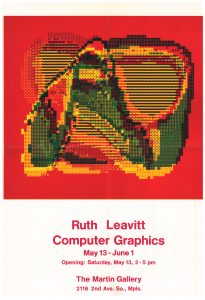In the series called “The ABCs of the Corcoran Artist Files” the American Art and Portrait Gallery (AA/PG) Library will explore artists through the materials from the recent Corcoran Vertical File Collection donation by featuring artists whose surnames begin with that letter. This time we are looking at the artists whose last names start with L. This exhibition and blog post were curated and written by Emily Moore, the Instruction and Outreach Archivist at the University of Oregon, who was a 2019 summer intern at the AAPG Library. After a pandemic pause, materials are once again on display in the library.
The discovery of a vertical file collection is an act of exploration – a loose construction of a life and career, presented visually through ephemeral materials. Dealing in both the personal and professional, these signifiers pique the interest of researchers and art explorers alike, encouraging the finder to continue to follow the line of a paper narrative. This opportunity for discovery occurs in a time capsule, in the unmapped elements of the research puzzle, encouraging the resolution of paper pieces put together in an organic, instinctual way. While working in the Corcoran files, I underwent a process of discovery that revealed personalities and art, both wonderful and strange, including the pulpy and brutal photos of Bud Lee and the early digital art pioneer Ruth Leavitt.

Born in New York as the son of a career diplomat, Bud Lee (1941-2015) was known for his striking, off-beat, and slightly surreal photographs and portraiture, appearing in publications including Life, Rolling Stone, Esquire, Harper’s, Town & Country, Vogue, Ms., and Mother Jones. His “kitschy, whimsical and Fellini-esque” work covered a wide spectrum of subjects, including the cover of Al Green’s Let’s Stay Together, portraits of legendary directors Francois Truffaut, Frederico Fellini, and Michelangelo Antonioni, and an incredible double portrait of Church of God founders and leaders Dr. O.L Jaggers and Miss Velma.[i]
In addition to his shots of celebrities and art, Lee’s work in education and Civil Rights included documenting four days of rioting in Newark, unrest that left 26 dead and hundreds injured. His image of Joe Bass, aged 12, lying on the ground, shot during an altercation between looters and the police, appeared on the cover of Life brought the “long, hot summer” of 1967 into homes all over America.
Towards the end of his life, Lee suffered a stroke that left him blind in one eye and paralyzed down his whole left side. Exalted as both an artist and journalist, the addition of Lee to the vertical file collection at the AAPG Library provides fascinating and often arresting information both on the work of Lee, and the lived experiences of his many subjects.

The work of Ruth Leavitt is simultaneously mechanical and organic, and an early example of the exploration of art and technology. Originally introduced to computers by her husband, a computer science professor, Leavitt “learned through osmosis” and brought an Abstract Expressionist sensibility to the format.[ii] While studying with Peter Busa, a fellow Abstract Expressionist who also explored Indian Space painting, Leavitt shifted from the instinctual, physical painting of the Expressionist style to the data-driven, “conscious decision making” of working with a computer as co-collaborator.[iii] After using early software to experiment with distortion and transformation, Leavitt quickly grew frustrated with the technical limitations of existing programs and decided to write her own. Working with coders, Leavitt’s first program stretched and distorted her drawings, which went from “hard-edge, constructivist in style” to having the “lyrical qualities of Abstract Expressionism.”[iv] Through different iterations of her first program, Leavitt explored the dimensions of line and mass, as well as three-dimensional, projected figures and the concepts of attraction and repulsion. These experiments eventually resulted in paintings, graphics, serigraphs (silk screen) and work in film animation.
Leavitt described her sense of excitement over the possibility of creating her own tools and saw programming and technology as enabling creative vision while providing opportunity and access to new, marketable skills. Technology is, by its nature, interdisciplinary, and demands collaboration between human and machine. To Leavitt, the medium was as important as the message, and the technology she employed changed the meaning of her work. Despite this, however, Leavitt felt that there was no such thing as “computer art,” as the artist ultimately wields the power in creation.
As one of the first artists to work with computer programming, and an early female pioneer in digital art, Leavitt’s file supplements our textual narrative of both technology and the visual arts. In addition to her visual experimentation, Leavitt edited Artist and Computer, a 1976 text that featured the work and writings of 35 artists working in the new medium. The insights of her book, which is in the AAPG collection, is now supported by the inclusion of Leavitt herself in our vertical file collection.
Artists on display for the L’s of the Corcoran are:
Raymond Lark (1939- 2005), Ruth Leavitt (1944- ), Bud Lee (1941-2015), Joanne Leonard (1940- ), Les Levine (1935- ), Marilyn Levine (1935 – 2005), Harry Lieberman (1880 – 1983), Harvey K. Littleton (1922 – 2013), Fonchen Lord (1911 – 1993), George Luks (1867 – 1933), Joan Lyons (1937-)
More from The ABCS of the Corcoran Artist Files:
[i] Eric Snider, “A Life In Pictures,” Creative Loafing Tampa, April 6, 2005.
[ii] Ruth Leavitt, Ed., “Ruth Leavitt,” Artist and Computer. New York: Harmony Books, 1976.
[iii] Leavitt, Ed., Artist and Computer.
[iv] Leavitt, Ed., Artist and Computer.


Be First to Comment